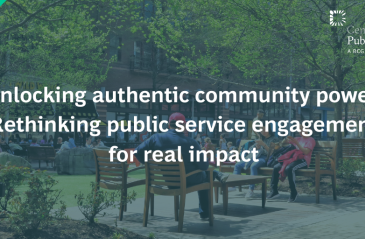
The power of storytelling in climate leadership

The city of Winston-Salem, North Carolina, is riding a tech and innovation wave
Share articleThe city's public, private and non-profit sectors worked together to reverse years of manufacturing decline
Share articleMayor Allen Joines is targeting new jobs and has plans to halve the city's poverty rate
Share articleWe put our vision for government into practice through learning partner projects that align with our values and help reimagine government so that it works for everyone.
Winston-Salem, North Carolina, 1997. A city beset by manufacturing woes: shuttered tobacco factories; a soaring unemployment rate; closed-down shops and businesses.
Winston-Salem, North Carolina, 2017. A city riding a non-stop wave of renewal: new innovation labs and research companies; a soaring job rate; new apartments, retail centres and hotels taking root.
It's quite a transformation - and one that is still ongoing. To set foot in the city's new Innovation Quarter, in particular, is to set foot in everything you want a thriving metropolis to be. The energy, the positivity is palpable. This is a place which is the fastest-growing research park in the US. It is a place where ambitious young professionals can set up shop and join the drive for pioneering medical and life sciences research. It is a place where new jobs and discoveries crackle forth on a daily basis. And it is a place which the city's mayor, Allen Joines, can rightly be very proud of.
And yet, he's not one for claiming credit. Although he has been mayor for the past 16 years and, as such, can surely lay claim for the turnaround occurring on his watch, he is keen to stress that this was a story of true collaboration, one where different sectors brought their own strengths to the table.
"In the public sector, we were able to bring some financial resources in terms of assisting with infrastructure like streetscape, fibre optic cable, and new parking facilities," he says. "The medical research industry also brought quite a lot of resources for their investment, as well as being willing to move a lot of their facilities into downtown. Developers brought development expertise and financing in order to get the projects actually completed. And finally, the state of North Carolina also played a huge role with the historic tax credits that, when combined with federal credits, were available to developers for restoring a lot of the older buildings in the innovation quarter. They got a 40% tax credit, which acted as additional equity for the project."
The scale - and success - of the regeneration is a testament (and rare example of) many groups and individuals abandoning party ties and coming together anew. Such an arrangement is hardly an everyday occurrence, however. So, why did it work in Winston-Salem? "It is one of those things where I like to use the phrase 'everybody grabbed the end of the same end of the rope'," replies Mayor Joines.
"We were all pulling in the same direction rather than in different directions because, being a traditional manufacturing city and seeing all those jobs disappear, we really had no choice but to repurpose our economy. I think everyone - Democrats, Republicans, blacks and whites - understood that if we didn't take demonstrative steps, we would be really in a vicious downward spiral."
The very diversity of this group was a key contributory factor in its success, he believes. "We had to have a broad spectrum of support to get it done, as well as a broad level of participation," he continues. "It was important just to keep moving forward and let the credit fall where it might lay. The other thing that was important was to take a long-term view of repurposing the economy. We didn't want to do it based on the current environment and then find ourselves in the same situation in 10 years' time. So we took a little time to make sure we were positioning ourselves for long-term growth and long-term stability."
That this occurred in North Carolina of all places makes the bipartisan success all the more remarkable. In recent months, the state has made international headlines after its legislature - controlled by the Republicans - sought to limit the powers of the incoming Democratic governor. Such a move became an example of the partisan, “take no prisoners” style of politics currently leading many to despair. And yet just down the road lies Winston-Salem in all its regenerated glory. A mere 150 kilometres separates the town from the state capital of Raleigh, but the difference in approach couldn't be wider.
Joines, for one, takes pride in having political allies from both sides of the aisle. "I have always tried to position myself as someone who is bipartisan," he says. "I ran as a Democrat but I have huge Republican support here, and I try to stay right in the middle. I also have great relationships with the African-American minority community, so hopefully I am viewed as someone who is really trying to do the best for the entire community. And in local government, it is important to remember that we are the last bastion of service delivery and we have to have the police and firefighters out there, we have to pick up the trash, and keep all these services going. It is incumbent on us to work together and get things done."
Although he has many years in the mayoral hot seat, Joines has no wish to step aside any time soon. On the contrary, the mayor is very much focused on the road ahead. "We set a goal for ourselves of being in the top 50 metro-areas in the country, and that means we have to generate more job growth in order to meet this target," he says. "I'm hopeful that within the next five years we will make that list. Right now I think we are 141st, so we still have a way to go, but we have also got some very good initiatives under way that I think will bear fruit and allow us to hit that margin. The other thing I am hopeful for over the next 10 years is that we will significantly reduce the poverty rate here in the community as well. My personal target is to halve it over the next decade."
As an example of his approach to impact, the anti-poverty initiative is highly pertinent. Earlier this year, he and his colleagues rolled out a major new programme to try and address poverty in the city area. "We worked on this report for about 15 months, with numerous public meetings, and it involved a lot of community leaders and one-on-one discussions," he explains. "And this is how I try to achieve our goals. The primary thing I try to do is advance work with the key parties to make sure we have buy-in and participation as we develop each initiative before it is even announced. You have to get buy-in but also make sure it is genuine buy-in - not just lip service."
Doubtless such initiatives will keep the mayor more than busy in the months and years ahead. So much so that further attempts by Democratic Party elders to persuade him to run for higher office are likely to be, once again, politely rebuffed.
"I was asked to run for Congress in 2006 and I took a hard look at it then," he recalls. "And three years ago I was called about running for governor, but the fact is I love what I am doing. Today, I look around me and have no need or wish to go anywhere else - other than a vacation to London this summer!"












